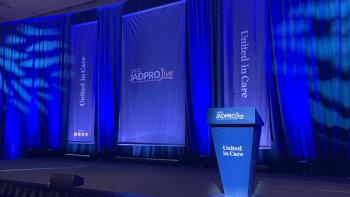
FDA Approves Lurbinectedin/Atezolizumab Maintenance Therapy in ES-SCLC
The FDA has approved lurbinectedin plus atezolizumab for the treatment of extensive-stage small cell lung cancer following induction therapy with atezolizumab.
The FDA has approved the use of lurbinectedin (Zepzelca) plus atezolizumab or atezolizumab (Tecentriq) and hyaluronidase-tqjs (Tecentriq Hybreza) for the treatment of patients with extensive-stage small cell lung cancer (ES-SCLC) whose disease has not progressed following frontline induction therapy with atezolizumab or subcutaneous atezolizumab, carboplatin, and etoposide.1
How Effective Is Lurbinectedin With Atezolizumab?
The approval is based on results from the phase 3, randomized, multicenter, open-label IMforte trial (NCT05091567). End points included overall survival (OS) and progression-free survival (PFS), assessed by independent review facility (IRF) per RECIST v1.1. OS was 13.2 months (95% CI, 11.9-16.4) in the lurbinectedin/atezolizumab arm and 10.6 months (95% CI, 9.5-12.2) in the atezolizumab arm (hazard ratio [HR] 0.73; 95% CI, 0.57-0.95; two-sided P = .0174).
Median PFS was 5.4 months (95% CI, 4.2-5.8) in the lurbinectedin/atezolizumab arm vs 2.1 months (95% CI, 1.6-2.7) in the atezolizumab arm (HR, 0.54; 95% CI, 0.43-0.67; two-sided P < .0001). These end points were measured from the time of randomization after completion of induction therapy.
The recommendation for this approval is as follows:
- Lubrinectedin: 3.2 mg/m2via IV every 21 days
Atezolizumab :- 840 mg every 2 weeks, 1200 mg every 3 weeks, or 1680 mg every 4 weeks if via IV, OR
- 1875 mg of atezolizumab with 30,000 units of hyaluronidase every 3 weeks if administered subcutaneously
What Patients Were Observed in IMforte?
Researchers of IMforte observed 483 patients with ES-SCLC who did not have disease progression after finishing 4 cycles of induction treatment with atezolizumab, carboplatin, and etoposide. Patients were randomized 1:1 to receive either lurbinectedin with atezolizumab delivered via IV or IV atezolizumab alone until either disease progression or unacceptable toxicity.
Lurbinectedin/Atezolizumab: What Do We Know?
“IMforte is the first phase 3 study to show PFS and OS improvement with first-line maintenance treatment for ES-SCLC, highlighting the potential of lurbinectedin plus atezolizumab to become a new standard of care [SOC] for first-line maintenance therapy in patients with this aggressive and difficult-to-treat disease,” Luis Paz-Ares, MD, PhD, of Hospital Universitario 12 de Octubre, H12O-CNIO Lung Cancer Unit, Universidad Complutense and Ciberonc, in Madrid, Spain, said in a press briefing ahead of the meeting.
Lurbinectedin’s label includes warnings for myelosuppression, hepatotoxicity, extraversion leading to tissue necrosis, rhabdomyolysis, and embryo-fetal toxicity. Atezolizumab’s label includes warnings for infusion-related reactions, complications of allogeneic HSCT, embryo-fetal toxicity, and immune-mediated adverse effects (AEs), which can be fatal.
“The safety profile of lurbinectedin plus atezolizumab was manageable, with mostly low-grade AEs and low treatment discontinuation rates,” Paz-Ares said. “No clinically meaningful increase in immune-related AEs was observed [with the addition of lurbinectedin],” he noted.
The most frequent AEs, occurring in 10% or more of those in the lurbinectedin/atezolizumab and atezolizumab arms, were nausea (36.4% vs 4.2%), anemia (31.8% vs 6.7%), fatigue (20.2% vs 7.9%), decreased appetite (16.9% vs 6.7%), decreased platelet count (15.3% vs 2.9%), diarrhea (14.0% vs 7.5%), vomiting (13.6% vs 2.5%), asthenia (12.8% vs 6.3%), thrombocytopenia (12.8% vs 1.7%), decreased neutrophil count (12.8% vs 1.3%), constipation (12.0% vs 6.3%), and neutropenia (10.7% vs 1.7%).
Lubrinectedin is an alkylating chemotherapy, and atezolizumab is a PD-L1-targeting immune checkpoint inhibitor.
Reference
- FDA approves lurbinectedin in combination with atezolizumab or atezolizumab and hyaluronidase-tqjs for extensive-stage small cell lung cancer. FDA. October 2, 2025. Accessed October 2, 2025. https://www.fda.gov/drugs/resources-information-approved-drugs/fda-approves-lurbinectedin-combination-atezolizumab-or-atezolizumab-and-hyaluronidase-tqjs-extensive
- Paz-Ares L, Borghaei H, Liu SV, et al. Lurbinectedin (lurbi) + atezolizumab (atezo) as first-line (1L) maintenance treatment (tx) in patients (pts) with extensive-stage small cell lung cancer (ES-SCLC): primary results of the phase 3 IMforte trial. Presented at: 2025 ASCO Annual Meeting; May 30-June 3, 2025; Chicago, IL. Abstract 8006.
Newsletter
Knowledge is power. Don’t miss the most recent breakthroughs in cancer care.


















































































